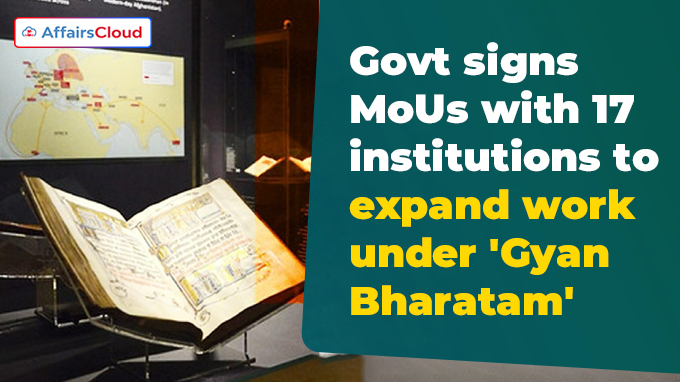In October 2025, the Ministry of Culture signed Memorandums of Understanding (MoUs) with 17 institutions across India, to accelerate work on the conservation and digitisation of India’s manuscript heritage under the ‘Gyan Bharatam Mission (GBM)’.
- These MoUs were signed in the presence of Union Minister Gajendra Singh Shekhawat, Ministry of Culture during a ceremony held at the National Gallery of Modern Art (NGMA) (Jaipur House) in New Delhi, Delhi.
Exam Hints:
- What? Signing of MoUs
- Entities: Ministry of Culture and 17 institutions in India
- Where? NGMA (New Delhi)
- Purpose: To accelerate the work of conservation of manuscripts under GBM
- Categorisation of Institutions: 12 (Cluster Centres) and 5 (Independent Centres)
- GBM:
- Restructured: NMM(established in 2003)
- Launched in: September 2025
- Total Budget: Rs 482.85 crore (from 2024-31)
- Financial Outlay for FY26: Rs 60 crore
Key Details of MoUs:
Grouping of 17 Institutions: Under the Gyan Bharatam framework, 12 institutions, including the Department of Persian Studies at the University of Kashmir (Jammu & Kashmir, J&K); and Asiatic Society (Kolkata, West Bengal, WB) have joined the initiative under the ‘cluster’ category.
- While, remaining 5 institutions including Nagari Pracharni Sabha (Varanasi, Uttar Pradesh, UP) have signed MoUs as ‘Independent Centres’.
Key Functions: Institutions in ‘Cluster Centre’ category will be responsible for executing all manuscript-related activities of its own centre and also for its designated Cluster Partner Centres, which shall not be more than 20.
- While, Institutions in ‘Independent Centre’ category will be responsible for implementing all manuscript-related activities pertaining solely to its own collection.
Significance: These centres will help in carrying forward the 5 key verticals of the initiative: Survey Cataloguing; Conservation & Capacity Building; Technology & Digitization; Linguistics & Translation; and Research, Publication & Outreach.
About Gyan Bharatam Mission (GBM):
Background: Initially, the Ministry of Culture established the National Mission for Manuscripts (NMM) in 2003, under the Indira Gandhi National Centre for the Arts (IGNCA), during the 10th Five Year Plan (FYP), to document, conserve, and promote access to India’s manuscripts heritage.
- Later, the Government of India (GoI) restructured the NMM as the GBM, the flagship initiative of Ministry of Culture, which was announced inthe Union Budget for Financial Year 2025-26(FY26).
Launched: In September 2025, Prime Minister (PM) Narendra Modi officially launched GBM, during the 1st –ever Gyan Bharatam International Conference held at Vigyan Bhawan in New Delhi.
Creation of NDR: The mission aims to create a ‘National Digital Repository (NDR)’ which will be accessible both at national and global platforms.
Budget Outlay: GBM, a Central Sector Scheme (CSS), has been allocated Rs 482.85 crore for the period from 2024-31, with more than 44.07 lakh manuscripts already documented in the Kriti Sampada digital repository.
- For FY26, the Government of India (GoI) has increased the financial allocation for the manuscripts initiative from 3.5 crores to Rs 60 crores.
Phase-wise Implementation: The mission will be implemented in three phases.
- Phase I: Establish institutional frameworks, launch pilot digitisation projects, and conduct training programmes.
- Phase II: Operationalise the NDR and expand access using advanced technology.
- Phase III: Enhance outreach through exhibitions, cultural events, and integration with national and global archives.
About Ministry of Culture:
Union Minister- Gajendra Singh Shekhawat (Constituency- Jodhpur, Rajasthan)
Minister of State (MoS)- Rao Inderjit Singh (Constituency-Gurugram, Haryana)





